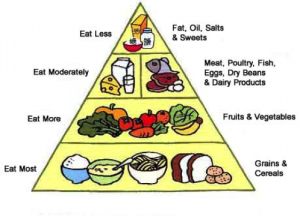Over the course of the past year I’ve seen – and experienced personally – many motivational ups and downs at work. To prepare for the year ahead, I decided to sit down this weekend and do some thinking about motivation and how I can be a better team member and leader heading into 2015. After thinking on it for a little while, I think there is actually a science to motivation. The analogy I keep coming back to is the food pyramid (the old school one, not the really confusing one or that new plate nonsense).
Keeping teams motivated is actually very similar to maintaining a healthy diet. Allow me to explain.
Let’s work our way down from the top.
The top of the pyramid is easy: fats and sweets are the motivational equivalent of free lunches, happy hours, and swag. If delivered after a wholesome “meal,” they are the perfect compliment, but served alone they’ll only provide a short sugar rush of team motivation followed by a quick relapse into unhappiness. These should be used sparingly and strategically.
Working our way down: meat, poultry and fish are the equivalent to giving the team an exciting project to work on. This is the heart of what we look forward to each day and what gets the team out of bed in the morning. Just like protein, exciting projects are the fuel that keeps us firing on all cylinders.
Dairy is the feeling that you are part of a close-knit team and battling for a common purpose. It’s very comforting and motivating to be part of a team and knowing that everyone else is working just as hard as you are. Teamwork is the motivational peer to a baked brie or a nice tall glass of milk.
Going down one more level: veggies are the equivalent to individual growth and skill accumulation. Sometimes the feedback required to grow and learn new things doesn’t taste very good, but just like vegetables, feedback and growth are the building blocks that will take us to the next level of our careers.
At the base of the pyramid, grains and cereals are the higher purpose and mission of your company. This is the slow burning fuel that pays off over long periods of time. It helps employees identify more closely with your company and the work that they’re doing each day. This level of the pyramid is perhaps the most important of them all. If done correctly it gives each employee, deep down inside, the irreplaceable feeling that they’re working to make a difference in the world.
If you provide the levels of the pyramid in the wrong proportions, your teams may get overweight, lazy and unhappy. If you don’t provide enough nutrition at all, they will slowly starve to death and vanish in front of you.
Equally important: no level of the pyramid, not even the base, can stand on it’s own. Teams need all levels of the pyramid in proper proportion to stay healthy and motivated.
